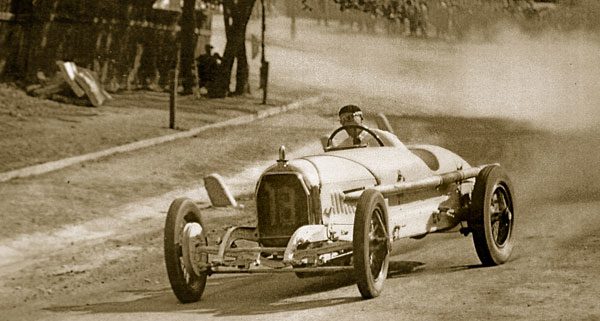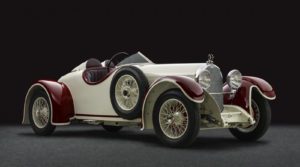„King of the Mountains” Hans Stuck and his Austro Daimler racing cars
A ADM-R racing car and a ADM-R „Torpedo” (1929) now in fahr(T)raum
Anyone scrutinising the history of European automobile racing sport in the last century will have encountered his name: Hans Stuck (1900-1978). The Bavarian started his career rather modestly as a milk delivery man where, as legend would have it, his driving style turned the milk into butter.
Hans Stuck at Austro Daimler
ADM-R „Stuck race car”, BJ. 1927
As a racing driver, he first drove a car he tuned and modified himself. After a contract with Austro Daimler in 1927 he became their most famous driver. On hillclimbs Hans Stuck was considered almost invincible, especially in the ADM-R Stuck racing car, which he called „greyhound” in his memoirs. This car was based on the ADM III Sport, with the ADM-R racing car being lighter and more powerful, and having a sports car body and an oversized steering wheel. Between 1927 and 1930, the „Bergkönig” (king of the mountains) achieved 46 victories with 41 daily best times in hillclimb races with this car. In 1929, at the „1st International St. Moritz Automobile Week”, with the Bernina hillclimb as the highlight, he took first place with a course record of 14:58:04 (average speed 66.4 km/h). In 1930 he even won the European Hill Climb championship.
As a private car, the racing legend Hans Stuck drove an ADM-R with fenders from 1929 – the „Torpedo„. An eye-catcher due to its wooden bodywork, it was powered by a 120 hp aluminium conrod motor with particularly high torque developed by engineer Karl Rabe. Only two of these cars were built.
With the withdrawal of Austro-Daimler from motorsport in 1930, Hans Stuck changed to Mercedes Benz.
Stuck at the Bernina hillclimb
In 2019, 90 years after the first Bernina Gran Turismo, another hillclimb race took place on the famous course – now shorter and asphalted, of course. This time Stuck’s son Hans Joachim „Striezel” Stuck, also a racing driver, was present. The fahr(T)raum classic car museum sent him into the race with a car similar to the one his father drove. His time of 5:15:56 was quite impressive. Only Ronnie Kessel was faster, in Clay Regazzoni´s Ensign F1 racing car from 1976.
You can admire a ADM-R Stuck racing car and the „Torpedo” at the Ferdinand Porsche Worlds of Experience in Mattsee near Salzburg. You can also learn more about Stuck’s life and racing history at the classic car exhibition in fahr(T)raum.
Joachim „Striezel” Stuck with our „Stuckwagen” at © Bernina Bergrennen / Leica.
AD-R 6 Sport „Torpedo” Stuck private car , BJ. 1929
Quellen
https://www.zwischengas.com/de/HR/rennberichte/Bernina-Gran-Turismo-2019.html
https://www.engadinerpost.ch/2019/09/23/Der-Kreis-schliesst-sich-90-Jahre-spaeter
Autorevue Premium Nr. 15
Bildnachweis
Bild 1, 2, & 4 fahr(T)raum Archiv
Bild 3 Joachim Stuck © Bernina Bergrennen / Leica
Das könnte Sie auch interessieren:









The world´s first four-wheel drive car was a Porsche
/Kategória: Geschichte, Rennautos, Sonstige Fahrzeuge, Uncategorized @huThe Lohner-Porsche, a vehicle that was far ahead of its time … just as its inventor Ferdinand Porsche. As early as 1897, Porsche designed a wheel hub motor for the purveyor to the imperial household Jacob Lohner on behalf of the „Jacob Lohner & Co.” imperial coachbuilding works in Vienna. Two years later, the young […]
Hard times: Porsche develops winches for mountain farmers after the war
/Kategória: Geschichte, Motoren, Uncategorized @huNEW at fahr(T)raum: a Type 335 winch from 1946 During the Second World War, Ferdinand Porsche had to move his „Dr. Ing. h.c. F. Porsche GmbH, Design and Consultancy for Motors and Vehicles” company, founded in 1931 and based in Kronenstraße 24, Stuttgart, due to Allied bombing raids. He relocated his design office classified as […]
The first traffic rules – displacement and adaptation caused by the automobile
/Kategória: Geschichte, Uncategorized @huAround 1900, as was the case for millennia, the horse still dominated in the transport of people and loads. Only the utmost upper class could afford private cars. In 1914, people were already crying „Vienna is choking with traffic”, although at that time there were only about 4,000 cars in Austria´s capital. Today, in Vienna […]